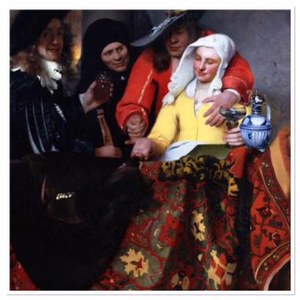The classification and identification of Oriental carpets only became an obsession of carpet connoisseurs during the 19th century and since no “actual” carpets of these painters were known to have survived at that stage, it was thought out of production and was given the name of the painter, eg. Holbein,Lotto, etc. Great was the joy, however, when real examples of these carpets were found at the end of the 1800’s in the Ottoman Empire, etc. Together with the Renaissance art a history of said carpets could finally be determent.
I recently watched a documentary on valuable paintings and Johannes Vermeer was also discussed. It struck me how many of his paintings had Oriental carpets in them too but because Johannes used different Oriental carpets in each one (albeit many of his paintings appear to be done in the same room), naturally no particular design of Oriental carpet was ever called a Vermeer carpet.
This could also be attributed to the fact that Johannes Vermeer, although being well known in his home town of Delft, practically disappeared from history after his sudden death at the age of 43 in 1675. Local patron, Pieter van Ruijven, purchased a large quantity of his total of 34 paintings shortly after and this further attributed to his art disappearing from the public eye. It would only be rediscovered by French art critic, Theophile Thore-Burger, in 1842 when he saw the “View of Delft” in the Mauritshuis in The Hague. He spent many years after searching for other works of Vermeer and eventually published a catalogue of his works.
Johannes Vermeer grew up during the Dutch Golden Age at a time when the home was regarded as a safe-haven from the lack of Christian virtue and immorality of the outside world. It was also a time when the Dutch expanded their influence in the Trade World and even though Dutch nobility/ landowners still held a high position in society, it was the wealthy merchants that held the greatest esteem. It was also these merchants that set the standards for displays of wealth and the middle class followed suit. Vermeer’s paintings consisted mostly of middle class men and women inside the home busy with daily life in Delft. Copying the high class members of society they are also placed in settings reflecting items that show some form of wealth including Oriental carpets. Interestingly all the Oriental rugs are placed on top of a table with none under foot possibly indicating the high value and esteem these items carried.
Johannes Vermeer deserves a nod of gratitude for showcasing these exquisite pieces of art in his paintings! Known for his love of using expensive colors (lapis lazuli comes to mind), not only are his paintings almost the most sought after in the world today, but I am certain so too would be the carpets that he so lovingly painted with expensive paints! Imagine owning an original Vermeer and the actual Oriental carpet appearing in the painting...Priceless!



